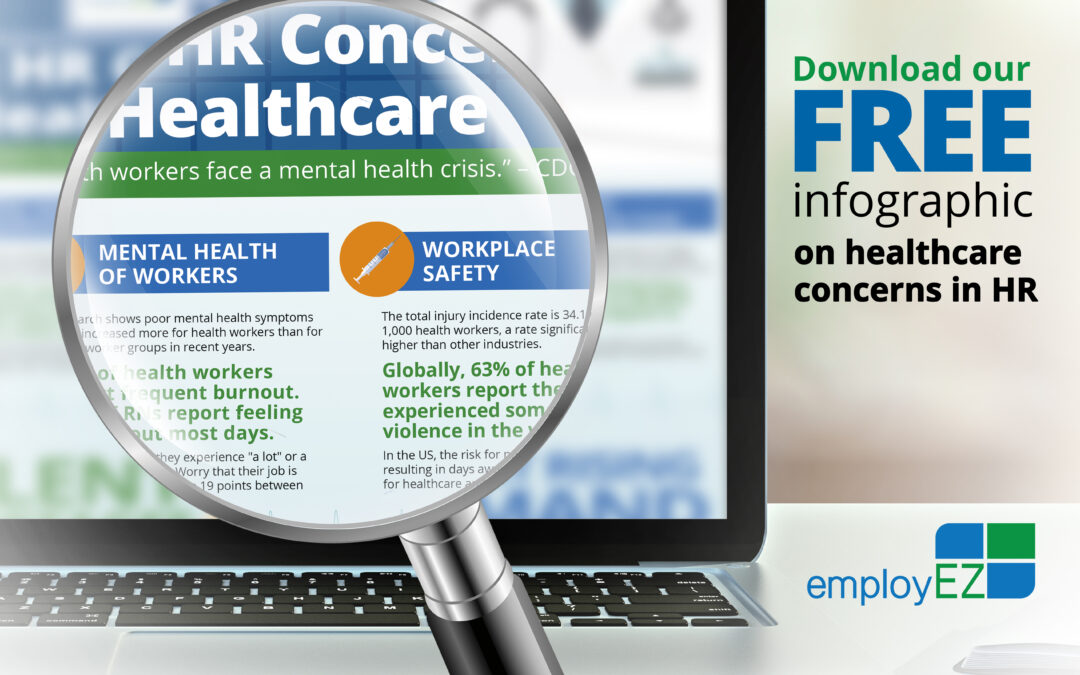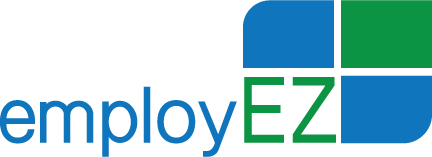
by Kaerrie Hall | May 13, 2024 | Human Resources
What’s keeping healthcare leaders up at night? Talent shortages and what the CDC calls “a mental health crisis” are some of the top HR concerns in healthcare. What else tops the list? Download our free infographic for insights into HR issues in healthcare and strategies to overcome them.
Overcoming the Top HR Concerns in Healthcare
Healthcare leaders, from small medical practices to large health systems, are managing stressed and overworked team members. They’re facing staffing and funding shortages. And they’re navigating complex business, regulatory and administrative challenges.
That’s not easy… but here’s what is:
Getting help from the employEZ family of Professional Employer Organizations (PEOs).
employEZ offers a full suite of HR outsourcing services to help your healthcare company:
Let’s discuss how we can help you overcome your top HR concerns. Reach out here to learn more.


by Kaerrie Hall | Apr 18, 2024 | Benefits of a PEO, Human Resources
There’s nothing more exciting than venturing out on your own, creating a business, and watching it grow. Soon, you’re attracting more customers to what you have to offer, and looking for more talent to help you deliver it. That’s great. But the bigger your company gets, the more you spend time managing it. That’s not a model for success. Here’s what is: Outsourcing HR-related services like HR administration, payroll processing, workers’ compensation, and employee benefits to a Professional Employer Organization (PEO).
Success with HR Outsourcing
That’s where we come in. The employEZ family of PEOs provides HR solutions and services that fit your business size and needs. Count on us to:
- Manage payroll processing and payroll tax reporting
- Provide claims management
- Stabilize your workers’ compensation costs
- Eliminate time-consuming HR administrative tasks
- Assist you with compliance in labor laws, OSHA, and other regulations
- Provide access to funding sources for your payroll
- Help you attract and retain top talent with comprehensive employee benefit packages, including healthcare insurance, dental, vision, and 401(k)
You’ll benefit from the relationships we’ve made with top companies, our purchasing power and our collective expertise.
Get Our Free Guide to HR Outsourcing
Want to know more about HR outsourcing through a PEO and the types of services they provide? Curious how companies like yours can benefit from having a co-employment relationship with a trusted PEO from the employEZ family of PEOs? Contact us today and request your free copy of our guide to HR outsourcing for small business success here: info.employ-ez.com/hr4smb.

by Antonia Valenzuela | Jan 18, 2024 | Human Resources, Workers' Compensation
Mastering workers’ compensation claims is crucial for businesses to effectively manage workplace injuries while controlling costs. By implementing best practices, businesses can ensure prompt reporting, effective documentation, and support for injured employees. Additionally, conducting thorough claims investigations, ensuring legal compliance, fostering open communication, and implementing cost control measures are essential for successful claims management. Here are some crucial best practices that businesses can adopt to excel in workers’ compensation claims management, fostering a secure and supportive work environment for their valued employees.
Encourage Prompt Reporting and Documentation
Encourage employees to promptly report workplace injuries or incidents. By doing so, businesses can ensure swift medical intervention and accurate claims processing. Maintaining comprehensive documentation, including incident reports, witness statements and medical records, supports the claims process and helps prevent potential fraudulent claims.
Provide Employee Assistance
Support injured employees by providing guidance on reporting procedures, available benefits, and their rights under workers’ compensation laws. Offering assistance in navigating the claims process and connecting them with appropriate medical providers fosters trust between the employer and employees, making the process more manageable for everyone involved.
Implement Return-to-Work Programs
Establish effective return-to-work programs that facilitate the injured employee’s transition back to suitable work. Providing modified duties or transitional tasks not only benefits employees by allowing them to contribute while recovering, but also minimizes the impact of absences on business operations and productivity.
Conduct Thorough Claims Investigations
Thoroughly investigate each workers’ compensation claim, gathering relevant facts, interviewing witnesses and reviewing documentation. Prompt investigations help identify potential red flags and protect the business from unnecessary costs, while enabling the implementation of corrective measures to prevent similar incidents in the future.
Ensure Legal Compliance
Stay informed about workers’ compensation laws and regulations. Adhering to reporting obligations and cooperating fully with the insurance carrier and regulatory authorities is essential to avoid fines, penalties and potential litigation.
Promote Effective Communication
Maintain open and transparent communication with all stakeholders. Keeping injured employees updated on their claim status and working closely with the insurance carrier to provide the necessary information and follow their guidance helps build trust, reduces misunderstandings, and ensures a smoother claims process.
Implement Cost Control Measures
Implement cost control measures, such as safety training programs, regular inspections, and employee safety awareness, to reduce the frequency and severity of workplace injuries. Proactive safety measures not only protect employees, but also contribute to lower workers’ compensation costs over time.
Mastering workers’ compensation claims is crucial for businesses to effectively manage workplace injuries while controlling costs. By adopting best practices such as prompt reporting, documentation, employee assistance, return-to-work programs, claims investigation, legal compliance, communication, and cost control measures, businesses can navigate the claims process efficiently and prioritize employee well-being. Implementing these practices establishes a safe and supportive work environment, benefiting both employees and the overall success of the business.
At employEZ, we understand the complexities of workers’ compensation claims and can help you implement best practices for such claims. We offer cost-effective workers’ compensation insurance and claims management. Our expert guidance and comprehensive solutions are designed to ensure that your business remains compliant, and your employees receive the support they need. Contact us today to empower your employees and safeguard your business with competitive workers’ compensation insurance rates and expert claims management.
For more insights on workers’ compensation regulations, visit your state’s Workers’ Compensation Board website.
You also might be interested in: https://employ-ez.com/workers-compensation-fraud-red-flags/

by Antonia Valenzuela | Oct 18, 2023 | Human Resources

by Antonia Valenzuela | Oct 9, 2023 | Human Resources
In today’s fast-paced business world, ensuring workplace safety and minimizing risks is not just a legal obligation; it’s a moral imperative. One of the key tools in achieving this is the Occupational Safety and Health Administration (OSHA) compliance checklist. In this article, we’ll explore the importance of OSHA compliance, and provide you with a comprehensive checklist to keep your workplace safe and secure.
The Significance of OSHA Compliance
Workplace safety is a top priority for every organization, and OSHA plays a pivotal role in achieving this goal. The Occupational Safety and Health Administration, established in 1970, is responsible for setting and enforcing safety and health regulations in the workplace. OSHA compliance is not just about avoiding hefty fines; it’s about safeguarding your employees and creating a culture of safety.
OSHA Compliance Checklist: Your Roadmap to Safety
To ensure workplace safety and minimize risks effectively, you need a roadmap to follow. This OSHA compliance checklist will serve as your guide:
1. Hazard Assessment:
Begin by identifying potential hazards in your workplace. Regular inspections and risk assessments are crucial for pinpointing risks.
2. Employee Training:
Ensure that all employees receive proper training on safety procedures and equipment usage. Training should be ongoing to keep everyone informed about the latest safety protocols.
3. Safety Equipment:
Provide and maintain necessary safety equipment, such as personal protective gear, fire extinguishers, and first-aid kits.
4. Emergency Response Plan:
Develop a comprehensive emergency response plan, including evacuation procedures, contact information, and designated meeting points.
5. Record Keeping:
Maintain thorough records of safety training, incident reports, and equipment maintenance. Documentation is essential for compliance and incident investigations.
6. Hazard Communication:
Implement a clear system for communicating hazards, including labels, signs, and safety data sheets for hazardous chemicals.
7. Safety Committees:
Establish safety committees comprising both management and employees to promote a collaborative approach to safety.
8. Regulatory Compliance:
Stay updated with OSHA regulations, and make necessary adjustments to your safety program accordingly. Explore more about OSHA regulations here.
9. Reporting and Investigating Incidents:
Promptly report and investigate all workplace incidents, and take corrective actions to prevent future occurrences.
10. Employee Involvement:
Encourage employees to actively participate in safety initiatives by soliciting their feedback and suggestions.
By incorporating these elements into your workplace, you not only achieve OSHA compliance but also foster a culture of safety that protects your most valuable assets—your employees.
How an EmployEZ PEO Can Help
OSHA compliance is not an option but a necessity for any responsible business. This OSHA compliance checklist for workplace safety provides you with the essential steps to minimize risks and ensure a secure environment for your employees. Remember, workplace safety isn’t a one-time effort; it’s an ongoing commitment. Prioritize OSHA compliance today, and together, let’s build safer, more secure workplaces for a brighter future. Contact employEZ for expert assistance in your journey toward workplace safety and regulatory compliance. Let us help you with employee management, risk management, workers’ compensation and more.
You may also be interested in: Identifying Red Flags for Workers’ Compensation Fraud


by Antonia Valenzuela | Aug 29, 2023 | Human Resources, Payroll
In the United States, employers must grasp the intricacies of overtime regulations and compliance guidelines to ensure adherence to the Fair Labor Standards Act (FLSA). Managing overtime pay for non-exempt employees correctly is vital for legal compliance and a harmonious work environment. In this blog, we delve into the responsibilities of employers concerning overtime regulations, including calculations, compliance guidelines, and best practices.
Properly Classifying Employees
Properly classifying employees as exempt or non-exempt forms the foundation of effective overtime management. This determination depends on their job duties and salary. Non-exempt employees receive overtime pay, while exempt employees do not. Misclassifying employees can result in costly legal consequences, underscoring the need for employers to carefully review job roles and, if necessary, seek legal counsel.
Calculating Overtime Pay
Calculating overtime pay for non-exempt employees requires precise considerations:
- Determining the Workweek: Establish a fixed and regularly recurring seven-day workweek. Consistency is key.
- Overtime Threshold: Overtime pay applies to hours worked beyond 40 in a workweek. Hours worked during holidays or weekends do not automatically qualify unless they exceed the 40-hour threshold.
- Hourly Employees: For non-exempt employees paid hourly, overtime is calculated as one and a half times (1.5x) their regular hourly rate for each hour worked beyond 40 in a workweek.
- Salaried Employees: For salaried non-exempt employees, calculate the regular rate of pay by dividing the weekly salary by the number of hours the salary is intended to compensate. Overtime pay is then computed at one and a half times (1.5x) the regular rate for each hour worked beyond 40 in a workweek.
Compliance Guidelines for Employers
To ensure compliance with overtime regulations in the US, employers should adhere to these guidelines:
- Maintain Accurate Records: Keep detailed records of all employees’ work hours, wages, and overtime pay, including time cards and timesheets.
- Communicate Overtime Policies: Clearly convey your company’s overtime policies to employees, providing written guidelines on calculations and reporting hours.
- Monitor Work Hours: Implement a reliable time tracking system to accurately monitor employees’ work hours and ensure proper clocking in and out.
- Train Supervisors and Managers: Educate supervisors and managers about overtime regulations, employee classification, and the importance of policy adherence.
- Periodically Review Policies: Regularly review overtime policies to comply with federal and state regulations and update them accordingly.
It’s essential for US employers to understand and comply with overtime regulations and compliance guidelines. Accurate employee classification, precise overtime pay calculations, and thorough record maintenance are necessary. By implementing the compliance guidelines and best practices discussed in this article, employers take an essential step toward creating a fair and compliant work environment, promoting positive employee relations, and avoiding potential legal issues related to overtime pay.
Two Great Ways to Streamline HR-Related Compliance
The employEZ family of Professional Employer Organizations (PEOs) helps you manage the employee side, of your business, including HR compliance. We offer a full suite of HR solutions and services such as payroll administration, workers’ compensation, claims management, and more. And our reliable time tracking solution, EZ Clock, is user-friendly software that simplifies tracking employee work hours, calculating overtime pay, and maintaining accurate records. Click here to learn more about EZ Clock and request a free demo. You can also explore our HR solutions and services here.
You may also be interested in: How a PEO Can Support Your Business In Managing Taxes.










